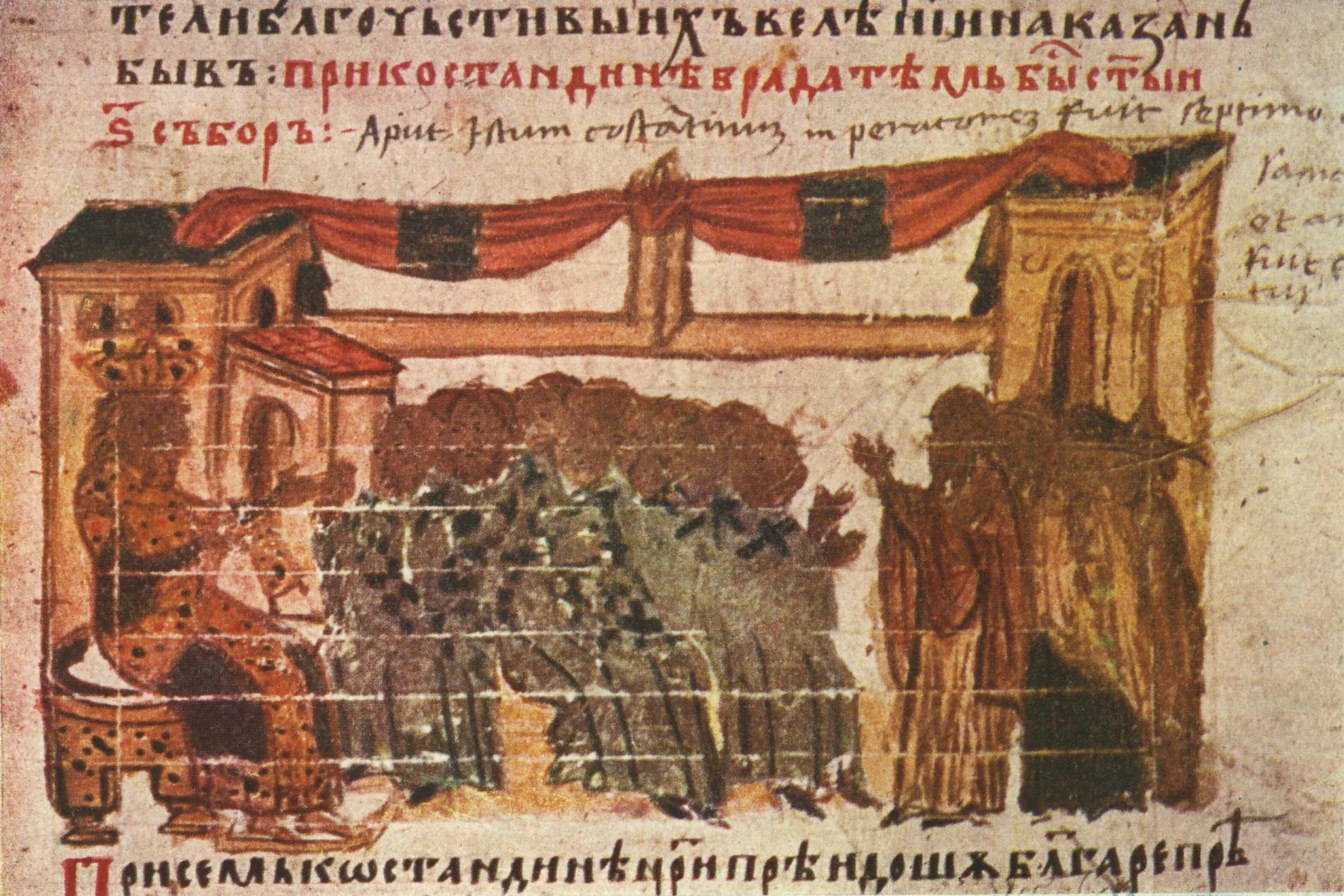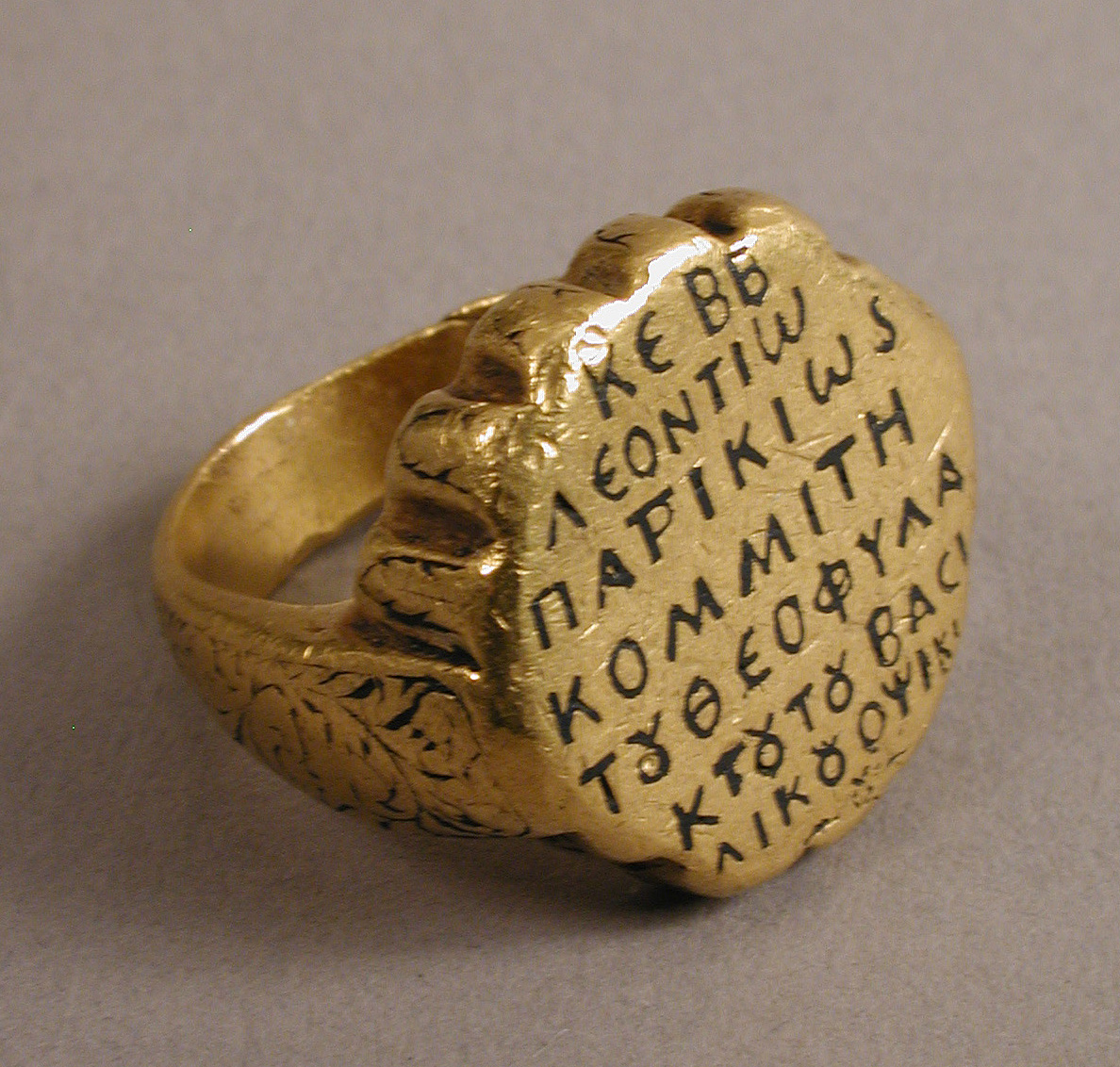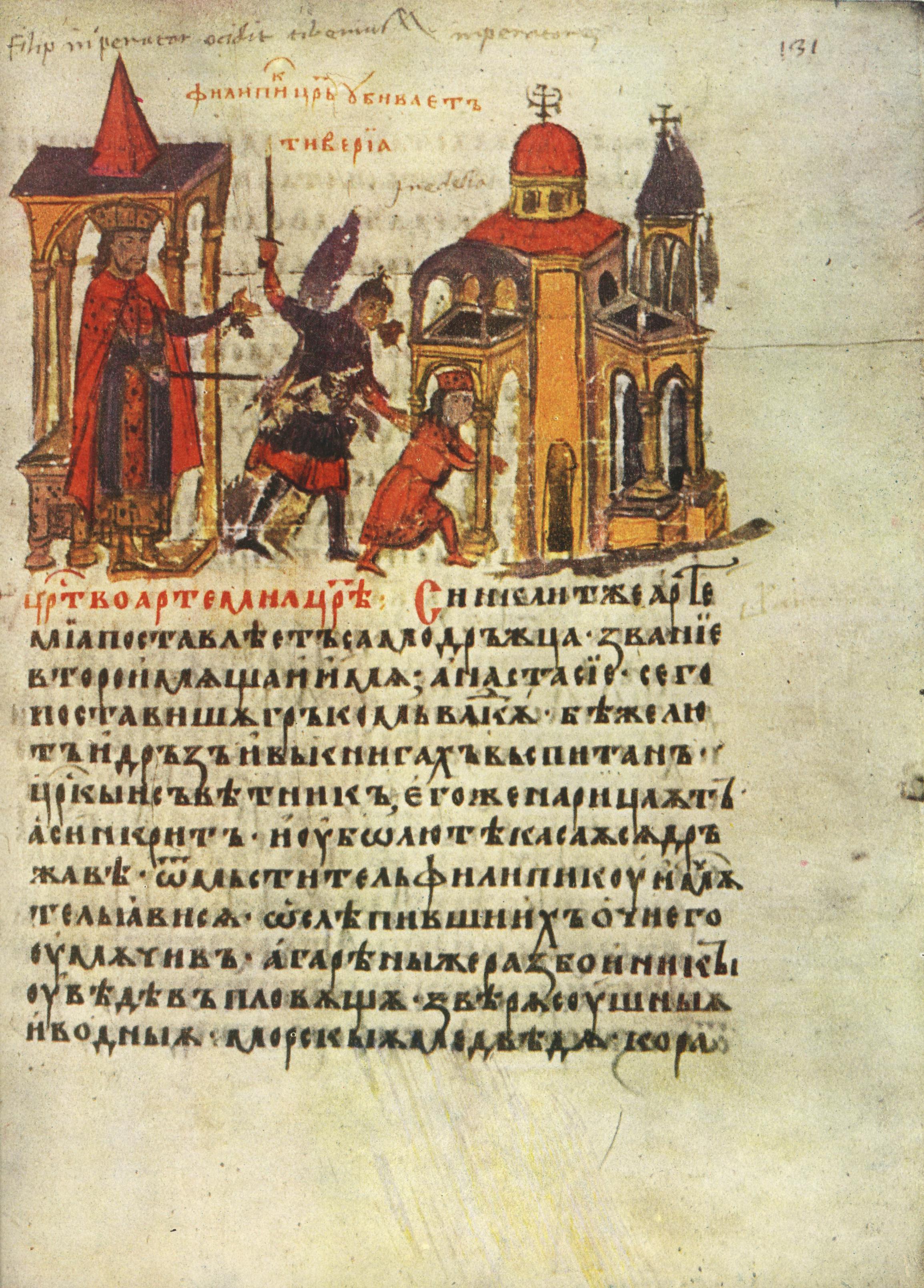|
Anastasius II (emperor)
Anastasius II ( la, Artemius Anastasius; el, Ἀρτέμιος Ἀναστάσιος, Artémios Anastásios, died 719) was the Byzantine emperor from 713 to 715. During his reign he reversed his predecessor's decision to appoint a Monothelete Patriarch of Constantinople. He instead re-elevated Orthodoxy in Constantinople by appointing Germanus I to the position in order to gain Pope Constantine's favor. His reign was spent attempting to reinforce the Empire and bring it into an era of stability. He was deposed by Theodosius during the Byzantine campaign against the Umayyad Caliphate in 715. Four years later, in 719, Anastasius would launch a rebellion against Emperor Leo III with the intent to reclaim the throne. He initially received support in the form of soldiers and funds from Tervel of Bulgaria. But once Anastasius failed to enter Constantinople, the Bulgar forces he had brought complied with a request from Leo III to turn Anastasius and his allies over. Anastasius would ... [...More Info...] [...Related Items...] OR: [Wikipedia] [Google] [Baidu] |
Solidus (coin)
The ''solidus'' (Latin 'solid'; ''solidi'') or nomisma ( grc-gre, νόμισμα, ''nómisma'', 'coin') was a highly pure gold coin issued in the Late Roman Empire and Byzantine Empire. Constantine I, Constantine introduced the coin, and its weight of about 4.5 grams remained relatively constant for seven centuries. In the Byzantine Empire, the solidus or nomisma remained a highly pure gold coin until the 11th century, when several Byzantine Empire, Byzantine list of Byzantine emperors, emperors began to strike the coin with less and less gold. The nomisma was finally abolished by Alexius I in 1092, who replaced it with the hyperpyron, which also came to be known as a "bezant". The Byzantine solidus also inspired the originally slightly less pure Dinar (coin), dinar issued by the Muslim Caliphate. In Western Europe, the solidus was the main gold coin of commerce from late Roman times to Pepin the Short's Carolingian Renaissance#Carolingian currency, currency reform, wh ... [...More Info...] [...Related Items...] OR: [Wikipedia] [Google] [Baidu] |
Byzantine Greeks
The Byzantine Greeks were the Greek-speaking Eastern Romans of Orthodox Christianity throughout Late Antiquity and the Middle Ages. They were the main inhabitants of the lands of the Byzantine Empire (Eastern Roman Empire), of Constantinople and Asia Minor (modern Turkey), the Greek islands, Cyprus, and portions of the southern Balkans, and formed large minorities, or pluralities, in the coastal urban centres of the Levant and northern Egypt. Throughout their history, the Byzantine Greeks self-identified as ''Romans'' ( gr, Ῥωμαῖοι, Rhōmaîoi), but are referred to as "Byzantine Greeks" in modern historiography. Latin speakers identified them simply as Greeks or with the term Romei. The social structure of the Byzantine Greeks was primarily supported by a rural, agrarian base that consisted of the peasantry, and a small fraction of the poor. These peasants lived within three kinds of settlements: the ''chorion'' or village, the ''agridion'' or hamlet, and the ''proast ... [...More Info...] [...Related Items...] OR: [Wikipedia] [Google] [Baidu] |
Galatia
Galatia (; grc, Γαλατία, ''Galatía'', "Gaul") was an ancient area in the highlands of central Anatolia, roughly corresponding to the provinces of Ankara and Eskişehir, in modern Turkey. Galatia was named after the Gauls from Thrace (cf. Tylis), who settled here and became a small transient foreign tribe in the 3rd century BC, following the Gallic invasion of the Balkans in 279 BC. It has been called the "Gallia" of the East. Geography Galatia was bounded on the north by Bithynia and Paphlagonia, on the east by Pontus and Cappadocia, on the south by Cilicia and Lycaonia, and on the west by Phrygia. Its capital was Ancyra (i.e. Ankara, today the capital of modern Turkey). Celtic Galatia The terms "Galatians" came to be used by the Greeks for the three Celtic peoples of Anatolia: the Tectosages, the Trocmii, and the Tolistobogii. By the 1st century BC, the Celts had become so Hellenized that some Greek writers called them ''Hellenogalatai'' (Ἑλληνογαλάτ� ... [...More Info...] [...Related Items...] OR: [Wikipedia] [Google] [Baidu] |
Catholic Church
The Catholic Church, also known as the Roman Catholic Church, is the largest Christian church, with 1.3 billion baptized Catholics worldwide . It is among the world's oldest and largest international institutions, and has played a prominent role in the history and development of Western civilization.O'Collins, p. v (preface). The church consists of 24 ''sui iuris'' churches, including the Latin Church and 23 Eastern Catholic Churches, which comprise almost 3,500 dioceses and eparchies located around the world. The pope, who is the bishop of Rome, is the chief pastor of the church. The bishopric of Rome, known as the Holy See, is the central governing authority of the church. The administrative body of the Holy See, the Roman Curia, has its principal offices in Vatican City, a small enclave of the Italian city of Rome, of which the pope is head of state. The core beliefs of Catholicism are found in the Nicene Creed. The Catholic Church teaches that it is the on ... [...More Info...] [...Related Items...] OR: [Wikipedia] [Google] [Baidu] |
Patriarch John VI Of Constantinople
John VI (Greek: Ιωάννης ΣΤ΄, ''Iōannēs VI'' ), (? – July or August 715) was the Ecumenical Patriarch of Constantinople from 712 to 715. He had been proceeded by Patriarch Cyrus of Constantinople. He was in all sanctification, succeeded by His All-Holiness Germanos I of Constantinople. John VI was placed on the patriarchal throne in 712 by Emperor Philippikos, as a replacement for the deposed Patriarch Kyros. John was favored by Philippikos, because he shared his monothelite sympathies. The religious policy of the new patriarch and his emperor caused the temporary rupture of relations with the Church of Rome. However, in 715 the new Emperor Anastasios II deposed John VI and replaced him with the Orthodox Patriarch Germanos I. See also *Byzantine Empire *Eastern Orthodox Church *Ecumenical Patriarch of Constantinople *Monothelitism References * ''The Oxford Dictionary of Byzantium The ''Oxford Dictionary of Byzantium'' (ODB) is a three-volume histori ... [...More Info...] [...Related Items...] OR: [Wikipedia] [Google] [Baidu] |
Sixth Ecumenical Council
The Third Council of Constantinople, counted as the Sixth Ecumenical Council by the Eastern Orthodox and Catholic Churches, as well by certain other Western Churches, met in 680–681 and condemned monoenergism and monothelitism as heretical and defined Jesus Christ as having two energies and two wills (divine and human).George Ostrogorsky, ''History of the Byzantine State'' (Rutgers University Press, 1995), 127. Background The council settled a set of theological controversies that went back to the sixth century but had intensified under the emperors Heraclius () and Constans II (). Heraclius had set out to recover much of the part of his empire lost to the Persians and had attempted to bridge the controversy with monophysitism, which was particularly strong in Syria and Egypt, by proposing a moderate theological position that had as good support in the tradition as any other. The result was first monoenergism, i.e. that Christ, though existing in two natures (divine and h ... [...More Info...] [...Related Items...] OR: [Wikipedia] [Google] [Baidu] |
De Imperatoribus Romanis
''De Imperatoribus Romanis'' (''DIR'') is an online peer-reviewed encyclopedia about the emperors of the Roman Empire, including the Byzantine Empire. It was established in 1996 by Michael DiMaio, and hosted at Salve Regina University Salve Regina University is a private Roman Catholic university in Newport, Rhode Island, United States. It was founded in 1934 by the Sisters of Mercy and is accredited by the New England Commission of Higher Education. The university enrolls mo .... The ''Cambridge Companion to the Age of Constantine'' says it "offer sound overviews and a regularly updated bibliography". References External links Original website Second website [...More Info...] [...Related Items...] OR: [Wikipedia] [Google] [Baidu] |
Regnal Name
A regnal name, or regnant name or reign name, is the name used by monarchs and popes during their reigns and, subsequently, historically. Since ancient times, some monarchs have chosen to use a different name from their original name when they accede to the monarchy. The regnal name is usually followed by a regnal number, written as a Roman numeral, to differentiate that monarch from others who have used the same name while ruling the same realm. In some cases, the monarch has more than one regnal name, but the regnal number is based on only one of those names, for example Charles X Gustav of Sweden. If a monarch reigns in more than one realm, they may carry different ordinals in each one, as some realms may have had different numbers of rulers of the same regnal name. For example, the same person was both King James VI of Scotland and King James I of England. The ordinal is not normally used for the first ruler of the name, but is used in historical references once the name i ... [...More Info...] [...Related Items...] OR: [Wikipedia] [Google] [Baidu] |
Thrace
Thrace (; el, Θράκη, Thráki; bg, Тракия, Trakiya; tr, Trakya) or Thrake is a geographical and historical region in Southeast Europe, now split among Bulgaria, Greece, and Turkey, which is bounded by the Balkan Mountains to the north, the Aegean Sea to the south, and the Black Sea to the east. It comprises southeastern Bulgaria (Northern Thrace), northeastern Greece (Western Thrace), and the European part of Turkey ( East Thrace). The region's boundaries are based on that of the Roman Province of Thrace; the lands inhabited by the ancient Thracians extended in the north to modern-day Northern Bulgaria and Romania and to the west into the region of Macedonia. Etymology The word ''Thrace'' was first used by the Greeks when referring to the Thracian tribes, from ancient Greek Thrake (Θρᾴκη), descending from ''Thrāix'' (Θρᾷξ). It referred originally to the Thracians, an ancient people inhabiting Southeast Europe. The name ''Europe'' first referred to ... [...More Info...] [...Related Items...] OR: [Wikipedia] [Google] [Baidu] |
Theme (Byzantine District)
The themes or ( el, θέματα, , singular: , ) were the main military/administrative divisions of the middle Byzantine Empire. They were established in the mid-7th century in the aftermath of the Slavic invasion of the Balkans and Muslim conquests of parts of Byzantine territory, and replaced the earlier provincial system established by Diocletian and Constantine the Great. In their origin, the first themes were created from the areas of encampment of the field armies of the East Roman army, and their names corresponded to the military units that had existed in those areas. The theme system reached its apogee in the 9th and 10th centuries, as older themes were split up and the conquest of territory resulted in the creation of new ones. The original theme system underwent significant changes in the 11th and 12th centuries, but the term remained in use as a provincial and financial circumscription until the very end of the Empire. History Background During the late 6th and e ... [...More Info...] [...Related Items...] OR: [Wikipedia] [Google] [Baidu] |
Opsikion
The Opsician Theme ( gr, θέμα Ὀψικίου, ''thema Opsikiou'') or simply Opsikion (Greek: , from la, Obsequium) was a Byzantine Empire, Byzantine Theme (country subdivision), theme (a military-civilian province) located in northwestern Asia Minor (modern Turkey). Created from the imperial retinue army, the ''Opsikion'' was the largest and most prestigious of the early themes, being located closest to Constantinople. Involved in several revolts in the 8th century, it was split in three after ca. 750, and lost its former pre-eminence. It survived as a middle-tier theme until after the Fourth Crusade. History The Opsician theme was one of the first four themes, and has its origin in the praesential armies of the East Roman army. The term ''Opsikion'' derives from the Latin language, Latin term ''Obsequium'' ("retinue"), which by the early 7th century came to refer to the units escorting the emperor on campaign. It is possible that at an early stage, the ''Opsikion'' was garri ... [...More Info...] [...Related Items...] OR: [Wikipedia] [Google] [Baidu] |
Philippicus Bardanes
Philippicus ( la, Filepicus; el, Φιλιππικός, Philippikós) was Byzantine emperor from 711 to 713. He took power in a coup against the unpopular emperor Justinian II, and was deposed in a similarly violent manner nineteen months later. During his brief reign, Philippicus supported monothelitism in Byzantine theological disputes, and saw conflict with the First Bulgarian Empire and the Umayyad Caliphate. Biography Philippicus was originally named Bardanes (; hy, Վարդան, Vardan , italic=yes ); he was the son of the patrician Nicephorus, who was of Armenian extraction from an Armenian colony in Pergamum. The Armenian background of Philippicus has been supported by Byzantinist historians Peter Charanis and Nicholas Adontz, and disputed by Anthony Kaldellis. Kaldellis adds that Bardanes was probably born and raised in the Byzantine realm, as his father Nicephorus possibly was. Contemporaneous sources attest to Bardanes' tutoring, scholarly interests, learning and e ... [...More Info...] [...Related Items...] OR: [Wikipedia] [Google] [Baidu] |


.jpg)




